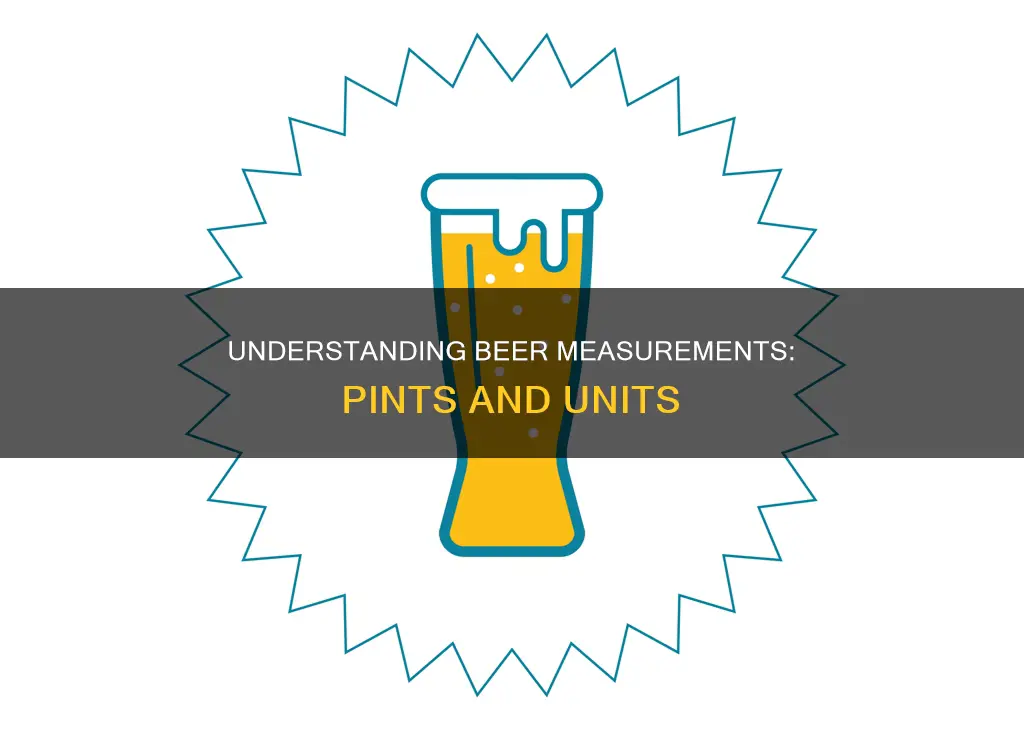
How many units of alcohol are in a pint of beer? It's a question that many drinkers in the UK have asked, and the answer is important for those wanting to keep track of their alcohol consumption. A unit of alcohol is a metric that calculates the amount of pure alcohol in a drink. In the UK, one unit is equal to 10ml or 8g of pure alcohol, which is the amount an average adult can process in about an hour. The number of units in a drink is based on its size and alcohol strength. A pint of standard-strength lager or ale with a 4.5% ABV contains 2.5 units of alcohol. However, the number of units can vary depending on the alcoholic content and the total volume of liquid. For example, a pint of lager with a 5% ABV contains nearly 3 units, while a pint of higher-strength lager with a 5.2% ABV contains 2.95 units. Understanding how many units are in a drink can help individuals make informed choices about their alcohol consumption and maintain a balanced lifestyle.
| Characteristics | Values |
|---|---|
| Number of units in a pint of beer | 2.3-2.95 units (depending on the strength of the beer) |
| One unit of alcohol | 10ml or 8g of pure alcohol |
| Time taken to process one unit of alcohol | 1 hour |
| Recommended standard amount of units per week | 14 |
What You'll Learn

A pint of standard-strength lager/ale contains 2.5 units of alcohol
In the UK, a unit of alcohol is defined as 10ml or 8g of pure alcohol. This is the amount of alcohol that the average adult can process in an hour. Therefore, within an hour there should, in theory, be little to no alcohol left in the blood of an adult. However, this varies from person to person depending on factors such as body size, age, gender, and metabolic rate.
The number of units in a drink depends on the size of the drink and its alcohol strength. For example, a pint of beer can contain anywhere from 1.9 to 4 units of alcohol, depending on its ABV (alcohol by volume). A pint of standard-strength lager or ale with an ABV of 4.5% contains 2.5 units of alcohol. This can be calculated as follows:
5% (ABV) x 568ml (volume of a pint) ÷ 1,000 = 2.5 units
It's important to note that not all beers have the same ABV, and the number of units in a serving depends on both the alcoholic content and the total volume of liquid consumed. For instance, a pint of 5% lager contains nearly 3 units of alcohol.
Understanding how many units of alcohol are in a drink is a useful way to keep track of your alcohol consumption and ensure it stays within the recommended limits. The UK government recommends that men and women should not regularly drink more than 14 units of alcohol per week. This is equivalent to around 6 pints of 4% beer. To keep health risks from alcohol at a low level, it's also advised to spread your drinking over 3 or more days and have several drink-free days each week if you regularly drink the maximum recommended amount.
Stout vs Ale Beer: Understanding the Key Differences
You may want to see also

ABV percentage and volume of liquid determine units in a pint
The number of units in a pint of beer depends on the volume of liquid and the ABV percentage. A unit is a metric used to calculate the amount of pure alcohol in a drink. In the UK, one unit equals 10ml or 8g of pure alcohol. This is the amount of alcohol that the average adult can process in an hour.
The ABV (alcohol by volume) is a measure of the amount of pure alcohol as a percentage of the total volume of liquid in a drink. For example, a drink with "12% ABV" or "alcohol volume 12%" means 12% of the volume of that drink is pure alcohol.
The number of units in a drink can be calculated by multiplying the total volume of the drink (in ml) by its ABV (as a percentage), and then dividing the result by 1,000.
For instance, a pint of beer with an ABV of 4% would contain 2.3 units of alcohol:
4 (ABV%) x 568 (ml) ÷ 1,000 = 2.3 units
Similarly, a pint of beer with a higher ABV of 5.2% would contain 2.95 units of alcohol:
2 (%) x 568 (ml) ÷ 1,000 = 2.95 units
The number of units in a pint of beer can vary depending on the ABV and the volume of liquid. It is important to note that the ABV and volume can differ between different types and brands of beer. Therefore, it is always a good idea to check the labels or ask bar staff about the ABV and volume to accurately determine the number of units in a pint of beer.
IPA, Wit, and XPA: What's the Difference?
You may want to see also

One unit of alcohol equals 10ml or 8g of alcohol
A unit of alcohol is a metric used to calculate the amount of pure alcohol in a drink. In the UK, one unit of alcohol is equal to 10ml or 8g of pure alcohol. This is different from the US, where they use the concept of standard" drinks, which contain around 14 grams of alcohol.
The reason that a single unit of alcohol is defined as 10ml in the UK is that this is the amount of alcohol that the average adult can process in an hour. Therefore, an hour after consumption, there should be little to no alcohol left in the bloodstream. However, it is important to note that this can vary from person to person.
The number of units in a drink depends on the size of the drink and its alcohol strength. For example, a pint of strong lager can contain 3 units of alcohol, while the same volume of lower-strength lager contains just over 2 units.
Understanding how many units of alcohol are in a drink is important for keeping track of your alcohol consumption and enjoying a balanced lifestyle. By knowing the number of units in a drink, you can make informed decisions about your drinking habits and ensure you stay within the recommended guidelines for alcohol consumption.
To calculate the number of units in a drink, you can use the following formula:
Strength (ABV) x volume (ml) ÷ 1,000 = units
For example, to calculate the number of units in a pint (568ml) of 4% ABV beer, you would do the following calculation:
4 (ABV%) x 568 (ml) ÷ 1,000 = 2.3 units
Explore the Differences: Ale, Bitter, and Beer
You may want to see also

A unit of alcohol is processed by the body in an hour
In the UK, a unit of alcohol is defined as 10ml or 8g of pure alcohol. This is the amount of alcohol that the average adult is able to process in about an hour. This means that, in theory, after an hour there should be little to no alcohol left in the bloodstream. However, it's important to note that this can vary from person to person.
The rate at which alcohol is metabolised depends on various biological factors, including weight, height, age, gender, body composition, genetics, and health. For example, women tend to have a higher body fat percentage and a lower water percentage than men, which can cause alcohol to remain in their system for longer. Additionally, younger individuals generally process alcohol faster and more effectively than older individuals.
The presence of food in the stomach can also impact the rate of alcohol absorption and metabolism. Food can absorb alcohol, prevent it from coming into direct contact with the stomach lining, and slow its transit to the small intestine, where it is rapidly absorbed into the bloodstream. This results in alcohol staying in the body for a longer period of time.
Medications can also affect how the body processes alcohol. Antidepressants and antibiotics, for example, can alter the way alcohol is metabolised. It is always recommended to consult a doctor before consuming alcohol while taking any medication.
To calculate the number of units in a drink, you can use the following formula:
Units of alcohol = (ABV x volume in ml) / 1000
For instance, a pint of 4% ABV beer contains approximately 2.3 units of alcohol.
A Pint of Beer: How Many Beers Is That?
You may want to see also

The UK's recommended alcohol limit is 14 units per week
The 14-unit figure is based on the expectation that it will cause an overall lifetime risk of death due to alcohol of approximately 1%. It's important to note that this guideline is not a safe level of drinking, as any amount of alcohol consumption increases the risk of developing cancer and other health problems. However, limiting intake to 14 units a week helps to keep the risk of illnesses like cancer and liver disease low.
To put this into context, 14 units are equivalent to around six pints of average-strength beer or six medium (175ml) glasses of average-strength wine. It's worth noting that the number of units in a drink depends on its size and alcohol strength. For example, a pint of lager can range from 2.3 to 2.95 units depending on its alcohol content.
To help manage alcohol consumption, it is recommended to spread drinking over three or more days and have several alcohol-free days per week. Additionally, it is advised to not binge drink and to limit alcohol consumption during pregnancy.
Budlight vs Amber Beer: Taste, Color, and Alcohol Content
You may want to see also
Frequently asked questions
The number of units in a pint of beer depends on the ABV (alcohol by volume) of the beer. A pint of beer with a 4% ABV contains 2.3 or 2.5 units of alcohol. A pint of beer with a 5% ABV contains 2.8 units of alcohol. A pint of strong lager with a 5.2% ABV contains 3 units of alcohol.
You can calculate the number of units in a drink by multiplying the ABV by the volume in millilitres and then dividing that number by 1000.
The recommended number of units of alcohol per week is 14 for both men and women.







